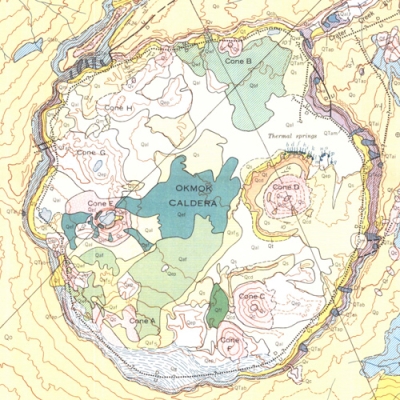This paper uses DMSP Special Sensor Microwave Imager (SSM/I) data supplied by NASA's National Snow and Ice Data Center Distributed Active Archive Center (NSIDC DAAC) and ERS-1 data from the Alaska Satellite Facility (ASF) DAAC.
Ocean convection is a globally important process in the production and ventilation of deep and intermediate waters. A key site of convection is in the Greenland gyre, related to an eastward extension of the ice edge called Odden ("the Icy Cape" in Norwegian). Oceanic convection involves individual plumes, clusters of plumes called chimneys, mesoscale eddies, and in the Greenland Sea, the embayments resulting from the surface outcropping of intermediate-level convective-return water. The processes of plume formation and convection are not well understood, and several mechanisms have been proposed for initialization of convection, including ice-edge upwelling.
This paper discusses passive microwave and synthetic aperture radar (SAR) satellite and in-situ data for 1989 and 1992. Features that are hypothesized to be the surface signals of the plumes, and possibly the eddies, are interpreted in the context of a simple model of convection-driven ice-edge retreat causing growth of an embayment in Odden called Nordbukta (North Bay). Imaging radar data seem to describe the surface structure resulting from convecting plumes and support our hypothesis that convective action in an area at the ice edge controls the ice edge motion in this region.
To generate regional sea ice distribution we used image data from the SSM/I. The interpretation of microwave radiance for new and young ice types is complex. The observed TB for new and young ice depends on thickness according to whether the ice grows in calm or rough seas. To obtain fine-scale data on ocean surface processes we used SAR data from the AMI on the European Space Agency (ESA) ERS-1.
The Polarization Ratio (37 GHz) for the Odden area for winter 1989 shows that convective events start about January 20; shortly thereafter an embayment forms at the ice edge and grows by steady ice retreat of 10 to 15 km d-1 to the southwest until about day 66. We assume that the Nordbukta growth (the ice retreat) is a consequence of convection, to at least intermediate depth.
Near day 30, three small scallop-shaped embayments appear in the ice edge, and these features migrate southwestward. The scallop on the eastern side of the convective embayments does not simply move SW; it closes into a migrating open-water feature which we argue is a convective sensible-heat polynya. All the scallops move at < 10 percent of the rate of the Nordbukta growth and are thus likely to be controlled by a common mechanism. Rapid ice retreat must be a consequence of the sensible heat brought to the surface by the convective-return upper Arctic Intermediate Water (uAIW). Visual inspection of 1989 data suggests an ice retreat rate of about 12 km d-1. Wind is the only external source for the rapid ice edge motion. If we speculate that the convective-return water terminates ice growth exactly, i.e., no ice at the ice edge is formed or melted after the convection begins, then the last ice that formed will move under simple wind forcing, and the open-water area will grow at that rate.
Calculations using Norwegian hindcast winds fail to disprove that wind advection is a control of ice retreat in mid- and later winter, but are neither strong enough to confirm wind-forcing nor to specify whether the ice at the edge is moving a bit faster or slower than the edge itself. The authors conclude that the satellite data indicate that the Nordbukta, as well as polynya-like features in the Odden ice cover, are a result of convection which is confined to an area smaller than 100 km across located at the retreating ice edge of the Odden or the leading edge of a migrating polynya.
Modeled and observed convection behavior are integrated to show the oceanic structure suggested by the satellite and ocean data for the central chimney and eastern polynya. The key features are the plumes, chimneys (aggregates of plumes) and open water. The key difference between the eastern polynya and the Nordbukta is that the former is advected as a closed, partially ice-covered chimney-like feature while the Nordbukta is an embayment, a difference probably arising from lower initial surface salinity in the polynya area. The same mechanism is inferred to operate in both the Nordbukta and the eastern polynya. The Odden region of the Greenland Sea probably has convection at work only in a few small (< 100 km) regions. There may be convective plumes in many other areas in the Greenland Sea, but to verify these will require additional satellite and in-situ data.
References
Carsey, Frank D. and Andrew T. Roach. 1994. In: The Polar Oceans and Their Role in Shaping the Global Environment. Johannessen, O. M., R. D. Muench, J. E. Overland, Editors. Geophysical Monograph 85. American Geophysical Union.
For more information
NASA National Snow and Ice Data Center Distributed Active Archive Center (NSIDC DAAC)
Special Sensor Microwave Imager (SSM/I)
| About the remote sensing data used | ||
|---|---|---|
| Data | Defense Meteorological Satellites Program (DMSP) Special Sensor Microwave Imager (SSM/I) European Remote Sensing Satellite (ERS-1) |
|
| Parameter | oceanic convection | |
| DAAC | NASA National Snow and Ice Data Center Distributed Active Archive Center (NSIDC DAAC) | |
